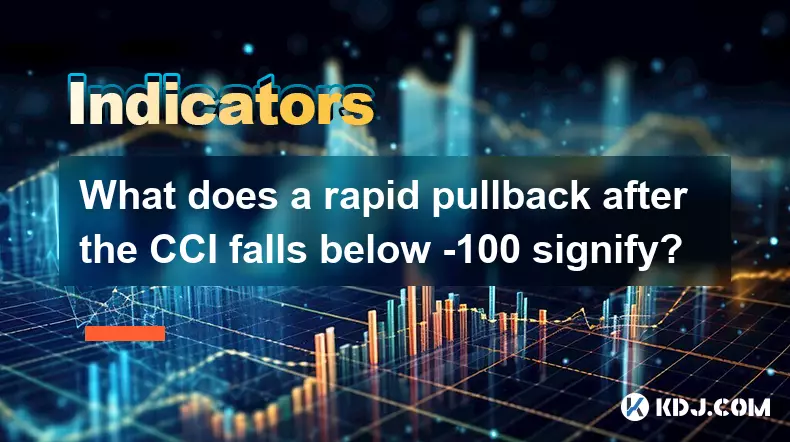-
 bitcoin
bitcoin $87959.907984 USD
1.34% -
 ethereum
ethereum $2920.497338 USD
3.04% -
 tether
tether $0.999775 USD
0.00% -
 xrp
xrp $2.237324 USD
8.12% -
 bnb
bnb $860.243768 USD
0.90% -
 solana
solana $138.089498 USD
5.43% -
 usd-coin
usd-coin $0.999807 USD
0.01% -
 tron
tron $0.272801 USD
-1.53% -
 dogecoin
dogecoin $0.150904 USD
2.96% -
 cardano
cardano $0.421635 USD
1.97% -
 hyperliquid
hyperliquid $32.152445 USD
2.23% -
 bitcoin-cash
bitcoin-cash $533.301069 USD
-1.94% -
 chainlink
chainlink $12.953417 USD
2.68% -
 unus-sed-leo
unus-sed-leo $9.535951 USD
0.73% -
 zcash
zcash $521.483386 USD
-2.87%
What does a rapid pullback after the CCI falls below -100 signify?
A rapid pullback after CCI drops below -100 often signals exhaustion of selling pressure and potential bullish reversal, especially if confirmed by volume and key support levels.
Sep 14, 2025 at 10:00 am

Rapid Pullback After CCI Drops Below -100: What It Signals
When the Commodity Channel Index (CCI) drops below -100, it typically indicates that an asset is entering oversold territory. This level suggests strong downward momentum and potential exhaustion in selling pressure. A rapid pullback following this event can carry significant meaning for traders operating within the cryptocurrency markets.
1. The drop below -100 on the CCI reflects intense bearish sentiment. In volatile markets like crypto, such extremes are common during sharp corrections or capitulation phases. When prices fall rapidly and the CCI breaches this threshold, it often means sellers have pushed the market to a short-term extreme.
2. A swift recovery after this breach may indicate that the selling has been absorbed by buyers stepping in at discounted levels. This kind of reaction is frequently observed in mature corrections where early panic gives way to accumulation by more strategic participants.
3. The speed of the pullback matters significantly—fast reversals suggest strong demand emerging right after oversold conditions are reached. In Bitcoin or major altcoin charts, these sharp bounces can mark the end of a downside leg and precede consolidation or even the start of a new upward move.
4. Traders watch for confirmation through volume and price action. A pullback accompanied by rising volume increases the reliability of the signal. Candlestick patterns such as bullish engulfing or hammer formations near key support levels add further validity.
5. False signals do occur, especially during extended downtrends. If the broader trend remains bearish and macro indicators align with continued weakness, a quick bounce off -100 might simply be a retracement before lower lows form.
Interpreting Market Structure Around CCI Extremes
Understanding context enhances the usefulness of any technical indicator, particularly one as sensitive as the CCI.
1. In a ranging market, readings below -100 followed by fast rebounds often reflect mean reversion dynamics. Crypto assets stuck in tight channels tend to oscillate predictably, making CCI a useful tool for identifying reversal zones.
2. During trending phases, especially strong downtrends, repeated trips below -100 without sustained recovery suggest ongoing weakness. A single pullback isn’t enough to declare a reversal; multiple higher lows in price and CCI must align.
3. Key structural levels such as previous swing lows, moving averages, or Fibonacci retracements should coincide with the CCI signal for higher-probability setups. For instance, a bounce from the 61.8% retracement level concurrent with CCI exiting oversold territory strengthens the case for a directional shift.
4. Timeframe alignment improves accuracy. A daily CCI crossing back above -100 supported by similar behavior on the 4-hour chart increases confidence in the developing momentum change.
5. Divergence analysis adds depth. If price makes a new low but CCI fails to reach a lower extreme, bullish divergence emerges—a powerful clue that momentum is weakening despite fresh lows.
Behavioral Dynamics Behind the Rebound
The psychology driving price movements becomes evident when examining reactions to extreme CCI values.
1. Panic-driven selloffs often push CCI deep into negative territory. Retail investors may liquidate positions out of fear, creating temporary imbalances that attract contrarian capital.
2. Market makers and algorithmic systems recognize these extremes and may initiate buying once predefined thresholds are hit. This institutional activity fuels rapid reversals.
3. Short squeezes can amplify the pullback—when leveraged traders are forced to cover positions amid a sudden uptick, it accelerates upward momentum. This phenomenon is prevalent in high-leverage crypto derivatives markets.
4. News cycles often coincide with these moves. Negative headlines trigger emotional selling, pushing CCI down, while clarifying updates or positive developments spark immediate reversals.
5. Order book depth plays a role. Thin order books on smaller exchanges allow price to overshoot fair value, increasing the likelihood of sharp corrections once stability returns.
Frequently Asked Questions
What timeframe is best for monitoring CCI signals in crypto trading?The 4-hour and daily timeframes provide reliable CCI readings due to reduced noise compared to lower intervals. These frames capture meaningful momentum shifts without excessive volatility distortion.
Can CCI alone confirm a trend reversal?No single indicator should be used in isolation. While CCI highlights overextended conditions, confirmation from volume, candlestick patterns, and structural support is essential before concluding a reversal.
How does CCI differ from RSI in crypto analysis?CCI measures cyclical deviations from statistical mean price, while RSI focuses on relative gains versus losses over a period. CCI has no fixed bounds, allowing it to exceed +100 or -100 repeatedly in strong trends, unlike RSI which is capped at 0–100.
Is a CCI reading below -100 always bearish?Not necessarily. Though it indicates strong downward momentum, in the context of a correction within an overall uptrend, it may simply reflect healthy profit-taking rather than the start of a new bear phase.
Disclaimer:info@kdj.com
The information provided is not trading advice. kdj.com does not assume any responsibility for any investments made based on the information provided in this article. Cryptocurrencies are highly volatile and it is highly recommended that you invest with caution after thorough research!
If you believe that the content used on this website infringes your copyright, please contact us immediately (info@kdj.com) and we will delete it promptly.
- Veteran Traders Eye Ozak AI: The Smart Crypto Play?
- 2025-11-29 19:40:01
- Price Prediction, Breakout, Sellers Tighten: What's Next for QNT and Altcoins?
- 2025-11-29 19:35:01
- XRP Shortage, ETF Frenzy, Digital Ascension: Are We Headed for a Supply Shock?
- 2025-11-29 19:25:01
- Hyperliquid's HYPE Network: $90 Million Transfer Sparks Debate, Top Fee Chain Status
- 2025-11-29 17:35:01
- Mutuum Finance (MUTM) V1 Launch: DeFi Lending Revolution on the Horizon
- 2025-11-29 17:40:01
- Solana, ETFs, and CoinShares: A Pivot in the Crypto Landscape
- 2025-11-29 17:40:01
Related knowledge

Can a Gravestone Doji at a Key Resistance Level Signal a Perfect Short Entry?
Nov 28,2025 at 09:40pm
Understanding the Gravestone Doji in Technical Analysis1. The Gravestone Doji is a candlestick pattern characterized by an opening and closing price t...

How to Tell if a Crypto Breakout is Real Using Candlestick and Volume Analysis?
Nov 28,2025 at 05:39am
Understanding the Anatomy of a Genuine Crypto Breakout1. A true breakout in the cryptocurrency market is not defined solely by price surpassing a resi...

The Definitive Guide to Entry and Exit Points Using Crypto Candlestick Patterns.
Nov 29,2025 at 06:59am
Understanding Bullish Reversal Patterns1. The hammer candlestick pattern typically appears at the end of a downtrend and signals a potential reversal....

What Does a Closing Marubozu Mean for the Next Day's Crypto Price Action?
Nov 28,2025 at 02:19am
Understanding the Marubozu Candlestick Pattern in Crypto Trading1. A Marubozu candlestick is a single-bar pattern characterized by the absence of uppe...

How to Filter Out Noise Using Longer Timeframe Candlestick Charts in Crypto?
Nov 28,2025 at 11:40pm
Understanding the Value of Higher Timeframes in Crypto Analysis1. Higher timeframe charts such as daily and weekly candlesticks offer a broader perspe...

What is a Tri-Star Pattern and Does it Signal a Major Crypto Turning Point?
Nov 29,2025 at 12:40pm
What is a Tri-Star Pattern in Cryptocurrency Trading?1. The Tri-Star pattern is a rare candlestick formation that appears on price charts, often signa...

Can a Gravestone Doji at a Key Resistance Level Signal a Perfect Short Entry?
Nov 28,2025 at 09:40pm
Understanding the Gravestone Doji in Technical Analysis1. The Gravestone Doji is a candlestick pattern characterized by an opening and closing price t...

How to Tell if a Crypto Breakout is Real Using Candlestick and Volume Analysis?
Nov 28,2025 at 05:39am
Understanding the Anatomy of a Genuine Crypto Breakout1. A true breakout in the cryptocurrency market is not defined solely by price surpassing a resi...

The Definitive Guide to Entry and Exit Points Using Crypto Candlestick Patterns.
Nov 29,2025 at 06:59am
Understanding Bullish Reversal Patterns1. The hammer candlestick pattern typically appears at the end of a downtrend and signals a potential reversal....

What Does a Closing Marubozu Mean for the Next Day's Crypto Price Action?
Nov 28,2025 at 02:19am
Understanding the Marubozu Candlestick Pattern in Crypto Trading1. A Marubozu candlestick is a single-bar pattern characterized by the absence of uppe...

How to Filter Out Noise Using Longer Timeframe Candlestick Charts in Crypto?
Nov 28,2025 at 11:40pm
Understanding the Value of Higher Timeframes in Crypto Analysis1. Higher timeframe charts such as daily and weekly candlesticks offer a broader perspe...

What is a Tri-Star Pattern and Does it Signal a Major Crypto Turning Point?
Nov 29,2025 at 12:40pm
What is a Tri-Star Pattern in Cryptocurrency Trading?1. The Tri-Star pattern is a rare candlestick formation that appears on price charts, often signa...
See all articles










































































